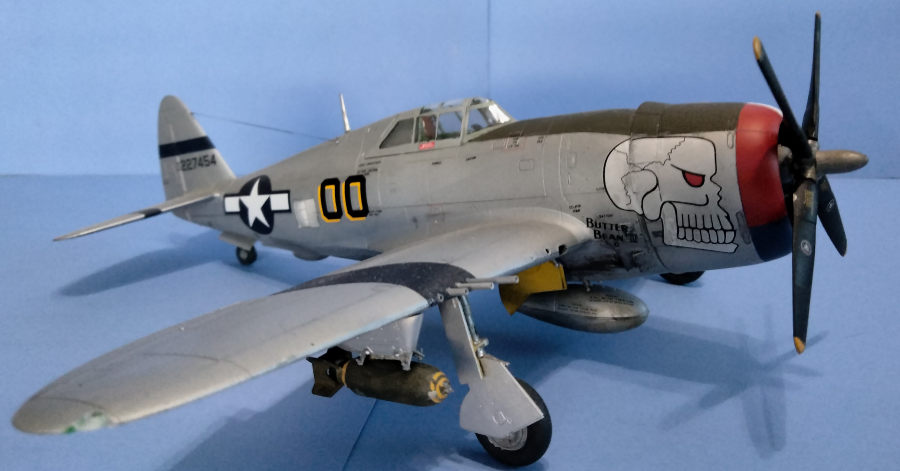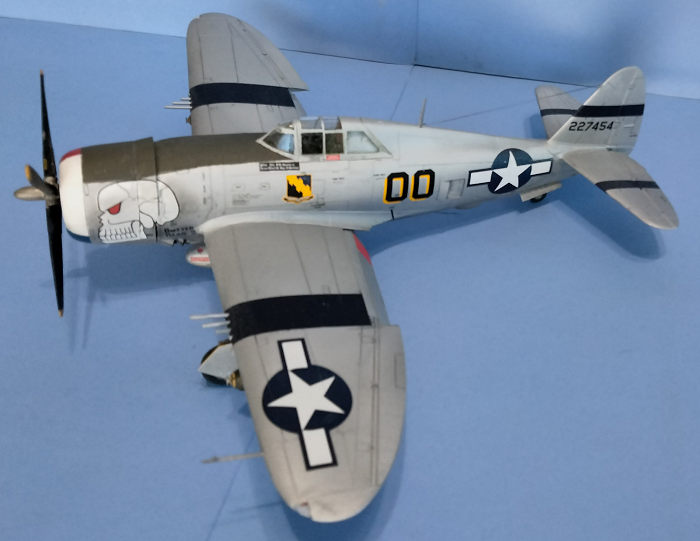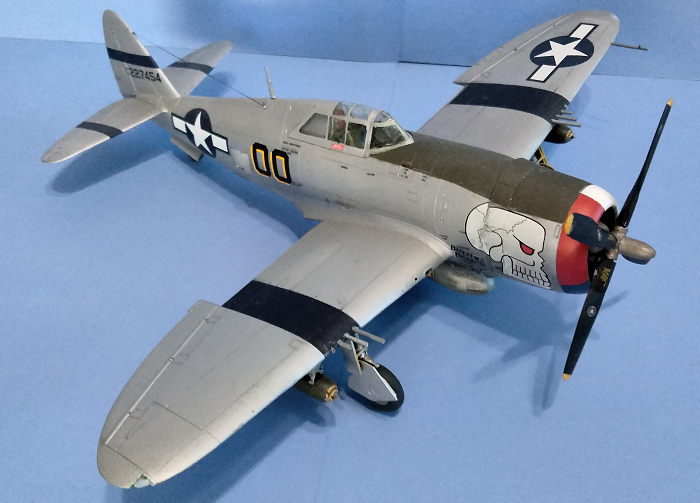
Tamiya 1/48 P-47D Thunderbolt
| KIT #: | 61086 |
| PRICE: | $40.00 |
| DECALS: | Three options |
| REVIEWER: | Mark Rossmann |
| NOTES: | Thundercals 48007 |

| HISTORY |
The P-47 was an outstanding escort and ground attack aircraft and was the heaviest and largest single seat fighter built during WWII. It rose out of a humble beginning which saw its ancestors the P-35 and P-43 fall short of expectations.
Early on the “Jug” was used as an escort to the ETO heavies but was replaced as the P-51 came on-line; its best role was that of a ground attack aircraft both in the ETO, MTO, PTO and CBI theaters. P-47’s was used by the U.S., British, French, Mexican, Brazilian and Russian air forces.
80th FG History
 On February 9, 1942, the
80th was activated at Selfridge Field, Michigan, with the 88th, 89th, and 90th
Pursuit Squadrons, July of 1942, the name change to Fighter Group was made. By
1943 they were ready for combat after training in the P-47 Thunderbolt and later
in the Curtis P-40.
On February 9, 1942, the
80th was activated at Selfridge Field, Michigan, with the 88th, 89th, and 90th
Pursuit Squadrons, July of 1942, the name change to Fighter Group was made. By
1943 they were ready for combat after training in the P-47 Thunderbolt and later
in the Curtis P-40.
On May 10 1943, the 80th headed for Karachi India and October 1943 a fourth squadron, the 459th, was formed with P-38Hs and assigned to the Chittagong area near Calcutta.
Then established a base in the Assam Valley just outside of northern Burma. The 80ths early prime mission was to escort and conduct combat air patrols for the cargo airlift to Kunming, China, the forgotten campaign over the ‘Hump’ of the Himalayas. Also
October 1943 began offensive strikes in northern Burma to protect allied engineers building the Ledo Road. Interdiction missions targeted airfields, supply depots, troop concentrations, and bridges especially on the Burma Railway.
Its motto, "Angels on our Wings," was aptly suited for this calling. The distinctive deaths head skull painted on each side of the engine cowling, sent a message that death and destruction was on the way to the Japanese. A belly mounted air siren was sometimes used, which created the ‘Banshee Wail, thus the nickname of ‘The Burma Banshees’ These markings were a contrast to the shark jaws often seen on Warhawks in U.S. and British service.
Soon missions extended into northern Burma, with offensive strikes to prevent the establishment of enemy bases from which Allied airlift planes might be attacked. Attacks were made from the Myitkyina Airdrome, to reduce Japanese attacks on the Hump cargo planes. It was the only all-weather strip for the defense of Burma from the north.
 From February 1944
through May 1944, a Herculean effort was made by the 80th group, to
support Merrill's Marauders, Pick's Engineers and Stilwell's composite forces,
during their drive down to Myitkyina. Countless dive bombing, (basically flying
artillery for the ground forces that had great difficulty negotiating the
treacherous Burma jungles with heavy equipment), strafing and napalm attacks
were made, many as close as 50 yards from our own troops. A particularly
effective deadly weapon, when dropped on troops in the jungle was a land mine,
which created terrific concussion.
From February 1944
through May 1944, a Herculean effort was made by the 80th group, to
support Merrill's Marauders, Pick's Engineers and Stilwell's composite forces,
during their drive down to Myitkyina. Countless dive bombing, (basically flying
artillery for the ground forces that had great difficulty negotiating the
treacherous Burma jungles with heavy equipment), strafing and napalm attacks
were made, many as close as 50 yards from our own troops. A particularly
effective deadly weapon, when dropped on troops in the jungle was a land mine,
which created terrific concussion.
Conversion
June 1944 conversion from P-40 to P-47 began, and by July, the 89th began operating P-47s from bases in Assam. Attacking Japanese forces in the Bhamo, Loiwing and Lashio areas, which was not accessible using the P-40’s.
Finally, the 80th was the first USAAF fighter group to be stationed in Burma since the Japanese pushed out the Flying Tigers in 1942, at Tingkawk Sakan in August 1944. It had a 4000-foot gravel runway carved out of a 200-foot-high teak forest with temperatures running well above 100 degrees.
In January 1945, it saw full operations from Myitkyina Burma, giving complete air superiority over northern Burma. The 80th had other daily challenges in the form of dense jungles, temperatures sometimes soared to 140 degrees with humidity near 100 percent. Crews worked in swarms of beetles, flies, and gnats. Sleeping required the use of mosquito netting with disease and fungi claiming more troops than opposing enemy fire.
The war ends
By the spring of 1945, targets were becoming scarce as the war was drawing to a close. When the 80th Fighter Group left Myitkyina, they had launched 18,873 planes on 4,719 missions, destroyed more than 200 bridges, 80 enemy planes in the air or on the ground. It received the Distinguished Unit Citation for heroic defense of a critical Indian oil refinery. Shortly after the end of the war in September, the 80th returned to the United States and was deactivated on November 3, 1945.
| THE KIT |
 This is a Tamiya P-47 Razorback, all are aware of the
high quality that this kit encompasses. The build took about 3 weeks. The
cowling was not attached so the painting was much easier to accomplish the red,
white and blue squadron colors. The only problem can be getting the wheels in
the proper position to the axel.
This is a Tamiya P-47 Razorback, all are aware of the
high quality that this kit encompasses. The build took about 3 weeks. The
cowling was not attached so the painting was much easier to accomplish the red,
white and blue squadron colors. The only problem can be getting the wheels in
the proper position to the axel.
Decal positioning for the head has a drawing on how to align the skull lines from the cowling to the main body.
Note: After the block number, Evansville aircraft were identified by the -RE suffix, while Farmingdale aircraft were given the -RA suffix.
| COLORS & MARKINGS |
 Aircraft: “00” – ‘Butter Bean II’, P-47D-23-RA,
227454 – Unknown Disposition,
Aircraft: “00” – ‘Butter Bean II’, P-47D-23-RA,
227454 – Unknown Disposition,
Unit: 80th FG, Tenth AF, Myitkyina Burma, Feb. 1945.
Pilot: Col. Snyder D Grubbs – CO 80th FG, February thru April 1945.
Model: Tamiya; P-47D Thunderbolt Razorback” Kit #86 1/48th
Decals: THUNDER CALS - 48007, Burma Banshees
Tamiya sprays: TS-17 Aluminum, TS-15 Blue, TS-27 – Pure White, TS-28 Olive Drab 2,
TS-86 Pure Red, AS-20 Insignia White
Tru-color Spray paint: TCP-4015 Gloss Dark Blue for the wing stripes.
(photos make it look black)
| CONCLUSIONS |
This is Tamiya. Pay attention to the alignment of the wheels to the axel. Can have flaps down or up, up position seems to be a bit more challenging to fit into the wing. The underwing identification lights need to be carefully cut through the decal for visibility. I do like how Hasegawa provides three different lenses to paint and can be inserted after the decaling is completed. THUNDER CALS are top of the line with detail information. These last ones were done by Cartographs new process. This one contains all you need to build one of the models, will need bar and stars and data from model sheet. All paints went on just fine, the only one is the white where I used and undercoating of AS-20 Insignia White first before using the Pure White, gives a better base to prevent bleed through.
| REFERENCES |
Decal Sheet
P-47 Thunderbolt with the USAAF in the MTO, Asia and Pacific – SMI Library (Kagero)
Armyaircorpmuseum.org site.
Burmabanshees.com
In Memory of Norris Grazer (Passed April 2023)
President and author of McKinstry IPMS Newsletter (Chicago Area), Owner THUNDER CALS / Contributor to P-47 Decals from Super Scale, Aero Master and Monogram Models. I had the honor to know Norris only by e-mail, for almost 2 years, before his passing. He always responded to my inquires about P-47s, provided tips and references. I purchased directly from him all of his P-47 sets, only produced in 1/48th scale, printed by Cartograph. I had the unique distinction of receiving pics of his last Burma Banshee decals when they arrived at his house, in May of 2022. He asked I not share them until they were for sale.
Please see this link for his Memoriam by James Hohenzy:
https://thundercals.com/in-memoriam-norris-graser/
16 January 2024 Copyright ModelingMadness.com. All rights
reserved. No reproduction in part or in whole without express permission from
the editor. If you would like your product reviewed fairly and fairly quickly, please contact the editor or see other details in the
Note to
Contributors. Back to the Main Page
Back to the Review
Index Page
Back to the Previews Index Page